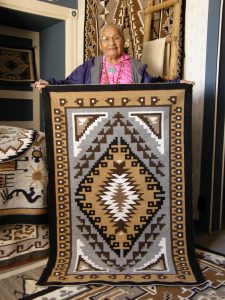660 Garcia Street
Santa Fe
NM
Native American Arts and Trading Posts of the Southwest
April 25-27, 2019
Cost per person:
Double Occupancy – $1,052 (Includes a $100 tax-deductible donation to SAR)
Single Occupancy – $1,174 (includes a $100 tax-deductible donation to SAR)
To register for this trip click here.
For hundreds of years, people of the American Southwest traded among themselves. They used a system of barter to exchange everything from furs, bison hides, foods, woven material, and clothing to pottery, beads, feathers, and turquoise. In the 1800s, the establishment of trading posts linked southwestern trade networks to those in the middle and eastern United States. Besides trade goods, trading posts provided places where people from different cultures exchanged ideas.
The traders were a tough breed. They often lived alone, miles from the nearest settlement, at a time when there were few roads and few or no cars or trucks. They learned to speak local languages and often acted as doctors, mediators, and postal workers for their Indian neighbors. They built trading posts out of the available materials of stone, logs, and adobe to store their supplies. The trading post became a center for socializing and exchanging information as well as goods. Besides storerooms, trading posts typically had a public room for trading where people could sit and talk for hours, often around a wood-burning stove.

Weaver Evelyn George, courtesy of Toadlena Trading Post
Today, most of the historic trading posts have closed, but there are a few that remain open and still trade with the local native cultures. Join fellow SAR members as we visit some of the most iconic trading posts in the Southwest. Learn about their history as well as their relationships with the surrounding Native American communities. Visits include Shiprock Trading Post, where we will meet with owners Kent and Hillary Morrow and silversmith Perry Shorty and Teec Nos Pos, where we will have a weaving demonstration by artist Roy Kady and tour by owner John McCulloch and Kathleen Foutz. On day two, the group will spend the morning at Toadlena Trading Post with owners Mark and Linda Winter who have invited the group for lunch and a weaving demonstration. We will tour at the Hubbell Trading Post, which has been serving Ganado since 1978 selling goods and Native American Art, and Joe Milos Trading Company which has been trading with the Navajo, Zuni and Hopi people since 1943.
We will meet with the executive director of the Navajo Nation Museum who will enlighten us on commerce and its impact on trade practices, art production and the cultural effect on the Native American communities, both good and bad. On the last day, the group will visit Zuni Pueblo and meet with Wells Mahkee, Jr. of Zuni Pueblo Main Street and another tribal member to learn about the arts at Zuni and the revitalization of their community.
Activity Level: Easy: Limited walking. Participants must be able to get in and out of vans and walk unassisted short distances from parking areas to museums or art studios.
Includes: Overnight accommodations at the Best Western in Farmington and the historic El Rancho Hotel in Gallup; two breakfasts, three lunches and one dinner; water and snacks on the bus; all admission fees and artist gratuities; and air-conditioned bus.
Field trips are open to SAR members and our Galisteo members and up receive priority registration. For more information about SAR’s field trips, including activity levels and our cancellation policy, please visit our field trips page here.